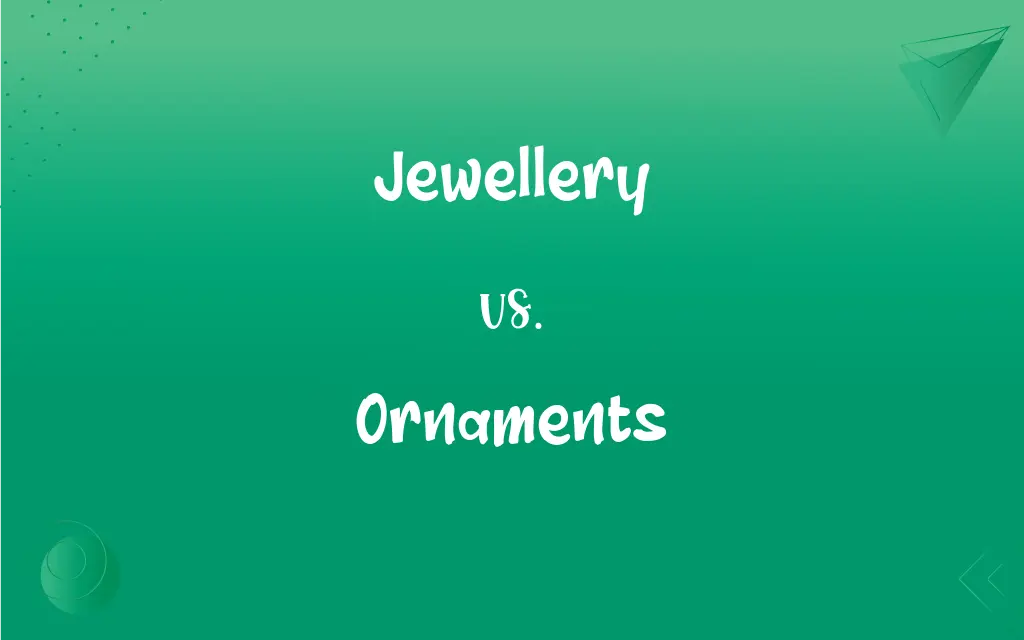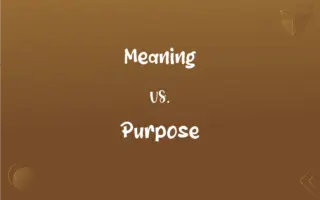Jewellery vs. Ornaments: What's the Difference?
Edited by Janet White || By Harlon Moss || Published on December 22, 2023
Jewellery refers to decorative items worn for personal adornment, typically made of precious metals and stones, while ornaments are broader, encompassing any decorative object used to enhance the appearance of a person or place.

Key Differences
Jewellery specifically denotes adornments like rings, necklaces, and bracelets, often crafted from valuable materials like gold, silver, or gemstones. Ornaments, however, can include a wider range of decorative items, not limited to personal adornment but also encompassing embellishments for spaces and objects.
The term jewellery usually implies a certain level of craftsmanship and material value, often associated with personal style and sometimes symbolic meanings like love or commitment. In contrast, ornaments can be made from a variety of materials, including less valuable ones, and are used for general decoration purposes.
Jewellery often serves as a status symbol or a form of investment due to its material value. Ornaments, on the other hand, are primarily intended to add aesthetic value to an environment or object, without necessarily implying a significant monetary investment.
In cultural contexts, jewellery can have deep-rooted symbolic meanings and is often integral to traditions and ceremonies. Ornaments, while also culturally significant, are more diverse in application, ranging from home décor to embellishments on clothing and tools.
Maintenance and care for jewellery typically require special attention due to its valuable components. Ornaments, depending on their material and purpose, may not require as much care and can vary greatly in durability and maintenance needs.
ADVERTISEMENT
Comparison Chart
Material Value
Often made of precious metals and gemstones.
Can be made from a variety of materials, including less valuable ones.
Purpose
Personal adornment, symbolic meanings.
General decoration, aesthetic enhancement.
Usage
Worn on the body.
Used to decorate spaces, objects, or worn on the body.
Cultural Significance
Often has deep-rooted traditions and symbolic meanings.
Culturally significant but more varied in application.
Care and Maintenance
Requires special care due to valuable materials.
Varies depending on material and purpose.
ADVERTISEMENT
Jewellery and Ornaments Definitions
Jewellery
Jewellery often denotes items like rings, bracelets, and necklaces, used as personal ornaments.
He gifted her a gold bracelet, adding another cherished item to her jewellery box.
Ornaments
Ornaments are not restricted to personal use but extend to home décor and embellishments on objects.
She added ornate ornaments to her dress, making it a unique piece of art.
Jewellery
Jewellery is typically crafted from materials like gold, silver, and gemstones.
Her jewellery collection featured an array of silver earrings with various gemstones.
Ornaments
Ornaments can include a wide range of items like figurines, wall hangings, and decorative accessories.
The shelf was lined with various ornaments, each telling a story of different travels.
Jewellery
In many cultures, jewellery holds significant traditional and ceremonial value.
For the ceremony, she wore traditional jewellery passed down through generations.
Ornaments
Ornaments are decorative objects used to enhance the appearance of a person or a place.
The Christmas tree was adorned with colorful ornaments, bringing festive cheer to the room.
Jewellery
Jewellery refers to decorative items made of precious materials, worn for personal adornment.
She wore a diamond necklace, the most exquisite piece of jewellery in her collection.
Ornaments
Ornaments can be made from diverse materials, including wood, metal, fabric, or plastic.
The artisan crafted wooden ornaments, each carved with intricate designs.
Jewellery
Jewellery can symbolize wealth, status, or personal sentiments like love or commitment.
The engagement ring, a piece of jewellery symbolizing their commitment, sparkled on her finger.
Ornaments
In various cultures, ornaments play a role in rituals, traditions, and celebrations.
For the festival, they decorated their home with traditional ornaments and lights.
Jewellery
Collectively, personal ornamentation such as rings, necklaces, brooches and bracelets, made of precious metals and sometimes set with gemstones.
She had more jewellery ornamented about her than any three ladies needed.
Ornaments
Something that decorates or adorns; an embellishment.
Jewellery
See Jewelry.
Ornaments
A person considered as a source of pride, honor, or credit
A singer who is an ornament to the world of opera.
Jewellery
An adornment (as a bracelet or ring or necklace) made of precious metals and set with gems (or imitation gems)
Ornaments
(Music) A note or group of notes that embellishes a melody.
Ornaments
To furnish with ornaments
Ornamented the windows with hanging plants.
Ornaments
To be an ornament to
"The babies ornament her ankles, dangle from her pant legs" (Carolyn Chute).
Ornaments
Plural of ornament
FAQs
Can ornaments be considered jewellery?
Some ornaments can be worn as jewellery, but ornaments have a broader scope including home and object decoration.
Are all jewellery items made of precious metals?
While many jewellery items are made of precious metals, some may use other materials for artistic or stylistic reasons.
What is the primary purpose of jewellery?
Jewellery is primarily worn for personal adornment and often carries symbolic meanings.
Is jewellery always expensive?
Not necessarily. Jewellery varies in price, from affordable pieces to high-value luxury items.
Is jewellery a common gift for special occasions?
Yes, jewellery is a popular gift for occasions like anniversaries, birthdays, and weddings.
Are ornaments only used during specific holidays?
While often associated with holidays like Christmas, ornaments can be used year-round for various decorative purposes.
Can jewellery have cultural significance?
Yes, many jewellery items hold cultural, traditional, or ceremonial significance.
Can ornaments be functional as well as decorative?
Some ornaments are purely decorative, while others can have functional aspects, like decorative storage boxes.
Is it common to inherit jewellery as heirlooms?
Yes, jewellery is often passed down as heirlooms due to its enduring value and sentimental significance.
Are ornaments limited to certain styles?
No, ornaments come in a wide range of styles, reflecting various artistic and cultural influences.
Can ornaments be used in outdoor settings?
Yes, ornaments can be designed for both indoor and outdoor use, depending on the material.
Is it common for jewellery to feature gemstones?
Many jewellery pieces feature gemstones for their beauty and value, but it's not a requirement.
Is jewellery often associated with fashion trends?
Yes, jewellery can be influenced by and contribute to fashion trends.
Can jewellery be custom-made?
Yes, custom-made jewellery is quite common, allowing for personalized designs and features.
Do ornaments require special care?
The care for ornaments depends on their material; some may need careful handling, while others are more durable.
Can ornaments be used in landscaping?
Yes, certain types of ornaments are designed for gardens and outdoor landscapes.
Can jewellery be a form of investment?
High-quality jewellery, especially with precious metals and stones, can be considered a form of investment.
Do ornaments have a historical significance?
Yes, ornaments often have historical significance, reflecting the art and culture of different eras and societies.
Do ornaments play a role in interior design?
Absolutely, ornaments are key elements in interior design, adding character and style to spaces.
Are ornaments used in religious ceremonies?
Ornaments can play a role in various religious ceremonies and celebrations.
About Author
Written by
Harlon MossHarlon is a seasoned quality moderator and accomplished content writer for Difference Wiki. An alumnus of the prestigious University of California, he earned his degree in Computer Science. Leveraging his academic background, Harlon brings a meticulous and informed perspective to his work, ensuring content accuracy and excellence.
Edited by
Janet WhiteJanet White has been an esteemed writer and blogger for Difference Wiki. Holding a Master's degree in Science and Medical Journalism from the prestigious Boston University, she has consistently demonstrated her expertise and passion for her field. When she's not immersed in her work, Janet relishes her time exercising, delving into a good book, and cherishing moments with friends and family.







































































